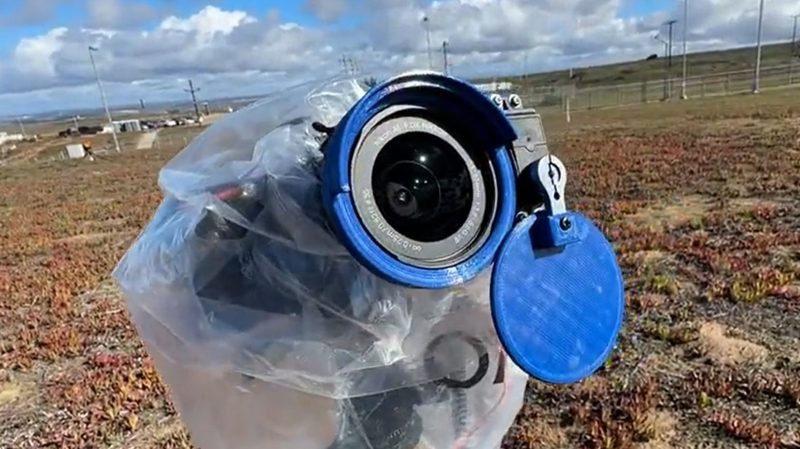Shooting space launches often requires the use of remote cameras for safety reasons. However, that means there’s no photographer on hand to wipe lenses down if they happen to get condensation from the prevailing weather conditions. [Michael Baylor] was having issues with atmospheric moisture interfering with his launch shots, so built a custom automatic lens cap to help solve the issue.
The design is simple, consisting of a large shutter that pivots to cover the camera lens when photos aren’t being taken, controlled by an impressively-beefy servo. Not only does the automatic cap protect the lens from condensation prior to the moment of launch, it also closes to cover the lens as the rocket leaves the frame. This protects the lens from all the dust and debris flying its way, kicked up by the rocket exhaust on takeoff.
[Michael] found that the lens cap easily outperformed his usual anti-condensation solution. While his camera with the auto-cap shot mostly-clean pics, another camera fitted with 18-hour handwarmers suffered significantly from condensation. The plan is to add just a little heat to the auto-cap setup to stave off condensation for good, even when shooting at pads like Vandenburg, California.
Details on the build are slim, but the basic concept is all there. Throw together a servo with some 3D-printed components and a microcontroller and you can build a setup custom-tailored to your own rig and use case. If you find yourself needing a capable long-range camera remote, too, we’ve seen those before as well! Video after the break.
First test of the actuated lens cap is a big success! There is a tiny bit of condensation on the lens, but my other camera at this spot with multiple hand warmers is way worse. Lens cap camera did not have any heaters or warmers.https://t.co/lAZDJvUqv4 pic.twitter.com/13bEDd6PmM
— Michael Baylor (@nextspaceflight) November 10, 2022
[Thanks to chgowiz for the tip!]

















If you are going to have an actively powered lens cover perhaps this is one of those rare occasions a peltier module for the heating also makes sense – not only does it radiate heat to the part you want to stay above the dewpoint but the other side will be a little colder than anything else around it and should therefor get most of the humidity settling on it I would think (assuming of course the air is reasonably still – in higher wind its all so stirred up all its doing is heating the hot side – which is all a plain resistive heater would have done too).
Always been a little in awe at the folks that manage to get really really sharp well framed remote launch images – black magic of getting the camera settings, fov and focus so dialed in when the target you wish to shoot doesn’t really exist yet. (Though maybe its easier than I think it would be, not something I’ve actually tried rather a long commute to go to anywhere there is spacelaunching)
If you’re just using it for heat I believe a heating element may be better than a peltier.
Indeed my thought is the cold side should help prevent condensation where you don’t want it more than just a heater – Because the cold side is going to be the spot all the humidity will most want to condense on so It takes the effective humidity out of the surrounding air somewhat.
Could you use the flash trigger to trigger the cover to shift automatically (if it moved faster)?
If you could move it in 1/2000 of a second, yes. Look forwards to seeing your pyrotechnic lens cover system…
Maybe not such a crazy idea. Most modern cameras (SLRs anyway) have pre-exposure flash communication happening and/or optical sync and/or pre-exposure flash metering. That happens dozens of milliseconds before the actual exposure. It’s easy to set up so that there is either an electrical signal or an optical flash available just before the exposure.
*Vandenberg
Try ordering some nichrome wire on Amazon.
You have to figure out the correct Guage size and current to use. As you are using a microcontroller for the servo, then use it to monitor temperature/ dew point and regulate the nichrome heating element.
A single shutter like this, and its ‘beefy servo’ impart a heck of kick on the mounting system when they activate, vibrating the whole mount and causing motion-blurred pictures. Operated slowly enough and with a wide enough lens, and with enough delay between cap opening and shutter firing, it might not matter so much. But the “real” solutions for this use a pair of shutter blades moving in opposite directions, so imparting zero lateral and rotational moment on the mount.
if anyone notices with a rocket going off nearby
True, dat. All in the application, ain’t it?
This opens before the camera starts snapping pics. More than enough time for the tripod to stabilize. Plus once the rocket is launching you do realize the camera will be subjected to much more vibration than a servo right?
I did something similar last year for an epson projector for a christmas thing for the kids. Relatively easy to do as well, a SG90 micro servo, esp32 module and a little some foam tape to give it a better seal for outdoors.
Use hair dryer it easy and smart and useful eaven in the rain. You can also use a filter to protect against dust.